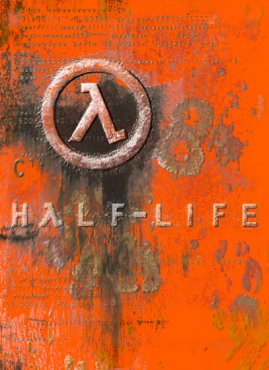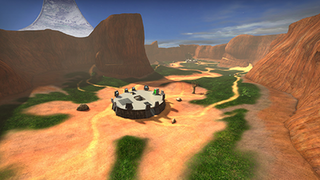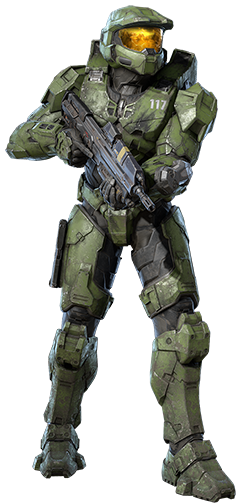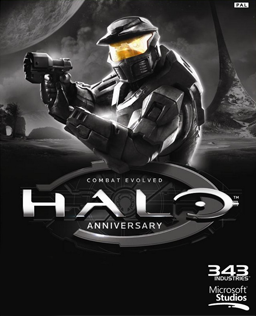
Half-Life is a 1998 first-person shooter (FPS) game developed by Valve and published by Sierra Studios for Windows. It was Valve's debut product and the first game in the Half-Life series. Players assume the role of Gordon Freeman, a scientist who must escape the Black Mesa Research Facility after it is invaded by aliens during an experiment gone wrong. The gameplay consists of combat, exploration, and puzzle-solving.

Halo: Combat Evolved is a 2001 first-person shooter video game developed by Bungie and published by Microsoft Game Studios for the Xbox. It was released as a launch game for Microsoft's Xbox video game console on November 15, 2001. The game was ported to Microsoft Windows and Mac OS X in 2003. It was later released as a downloadable Xbox Original for the Xbox 360. Halo is set in the twenty-sixth century, with the player assuming the role of the Master Chief, a cybernetically enhanced supersoldier. The Chief is accompanied by Cortana, an artificial intelligence. Players battle aliens as they attempt to uncover the secrets of the eponymous Halo, a ring-shaped artificial world.

Halo 2 is a 2004 first-person shooter game developed by Bungie and published by Microsoft Game Studios for the Xbox console. Halo 2 is the second installment in the Halo franchise and the sequel to 2001's critically acclaimed Halo: Combat Evolved. The game features new weapons, enemies, and vehicles, and shipped with online multiplayer via Microsoft's Xbox Live service. In Halo 2's story mode, the player assumes the roles of the human Master Chief and alien Arbiter in a 26th-century conflict between the United Nations Space Command, the genocidal Covenant, and the parasitic Flood.

Blood Gulch is a multiplayer map in the first-person shooter Halo video game series. It first appeared in Halo: Combat Evolved, and was remade for Halo 2 as "Coagulation", as well as for Halo: Reach as "Hemorrhage" and Halo: The Master Chief Collection as "Bloodline". It also had spiritual successors in Halo 3's "Valhalla", in Halo 4 and Halo Wars as "Ragnarok", and in Halo 5's "Basin". Taking place in a canyon on the Halo ringworld that resembles the American Southwest, it was designed for the Capture the flag game mode but can also be used for other modes, such as deathmatch. Blood Gulch was one of Halo's most critically acclaimed and influential multiplayer maps, and played a significant role in the machinima series Red vs. Blue.

The Flood is a fictional parasitic alien lifeform and one of the primary antagonists in the Halo multimedia franchise. First introduced in the 2001 video game Halo: Combat Evolved, it returns in later entries in the series such as Halo 2, Halo 3, and Halo Wars. The Flood is driven by a desire to infect any sentient life of sufficient size; Flood-infected creatures, also called Flood, in turn can infect other hosts. The parasite is depicted as such a threat that the ancient Forerunners constructed artificial ringworld superweapons known as Halos to contain it and, as a last resort, to kill all sentient life in the galaxy in an effort to stop the Flood's spread by starving it.

Master Chief Petty Officer John-117, or "Master Chief", is a fictional character and the protagonist in the Halo multimedia franchise. Master Chief is a playable character in the series of military science fiction first-person shooter video games Halo: Combat Evolved, Halo 2, Halo 3, Halo 4, Halo 5: Guardians and Halo Infinite. The character also appears in Halo books and graphic novels – including Halo: The Fall of Reach, Halo: The Flood, Halo: First Strike, and Halo: Uprising – and has minor appearances or cameos in other Halo media.

Halo 3 is a 2007 first-person shooter video game developed by Bungie for the Xbox 360 console. The third installment in the Halo franchise, the game concludes the story arc begun in 2001's Halo: Combat Evolved and continued in 2004's Halo 2. Halo 3's story centers on the interstellar war between twenty-sixth century humanity, a collection of alien races known as the Covenant, and the alien parasite Flood. The player assumes the role of the Master Chief, a cybernetically enhanced supersoldier, as he battles the Covenant and the Flood. The game features vehicles, weapons, and gameplay elements not present in previous titles of the series, as well as the addition of saved gameplay films, file sharing, and the Forge map editor—a utility which allows the player to perform modifications to multiplayer levels.

In the Halo science fiction universe, an Arbiter is a ceremonial, religious, and political rank bestowed upon Covenant Elites. In the 2004 video game Halo 2, the rank is given to a disgraced commander named Thel 'Vadam as a way to atone for his failures. Although the Arbiter is intended to die serving the Covenant leadership, the High Prophets, he survives his missions and the Prophets' subsequent betrayal of his kind. When he learns that the Prophets' plans would doom all sentient life in the galaxy, the Arbiter allies with the Covenant's enemies (humans) and stops the ringworld Halo from being activated. The Arbiter is a playable character in Halo 2 and its 2007 sequel Halo 3. The character also appears in Halo 5: Guardians and additional expanded universe material. A different Arbiter, Ripa 'Moramee appears in the 2009 real-time strategy game Halo Wars, which takes place 20 years before the events of the main trilogy.
Halo is a military science fiction media franchise, originally created and developed by Bungie and currently managed and developed by 343 Industries, part of Microsoft's Xbox Game Studios. The series launched in 2001 with the first-person shooter video game Halo: Combat Evolved and its tie-in novel, The Fall of Reach. The latest main game, Halo Infinite, was released in 2021.
The Halo video game and media franchise takes place in a fictional science fiction universe. In the distant past, a race known as the Forerunners fought the parasitic Flood. The Forerunners ultimately activate weapons of mass destruction, the Halo Array, in order to starve the Flood and stop the threat. By the 26th century, humanity, led by the United Nations Space Command (UNSC), is caught in a war with an alien coalition known as the Covenant. The Covenant worship the Forerunners as deities, mistakenly believing that the Halos are a tool of salvation, not destruction. The Flood, meanwhile, escape the confines of Halo and threaten to spread across the galaxy again.

The M12 Force Application Light Reconnaissance Vehicle, nicknamed Warthog, is a fictional armoured fighting vehicle that appears in the Halo video game franchise. An anti-infantry military light utility vehicle with a rear-mounted weapon turret, it appears in most major Halo titles as a drivable vehicle. Several working replicas of the Warthog were later created in real life, including by Weta Workshop for use in the cancelled Halo film. Playing an important role in defining the level design and genre of Halo: Combat Evolved during development, the Warthog is an iconic aspect of the Halo series and praised for its design, though the manner in which it has been integrated into the series' gameplay has received a mixed response.

Halo Wars is a real-time strategy (RTS) video game developed by Ensemble Studios and published by Microsoft Game Studios for the Xbox 360 video game console. It was released in Australia on February 26, 2009; in Europe on February 27; and in North America on March 3. The game is set in the science fiction universe of the Halo series in the year 2531, 21 years before the events of Halo: Combat Evolved. The player leads human soldiers aboard the warship Spirit of Fire in an effort to stop an ancient fleet of ships from falling into the hands of the genocidal alien Covenant.

Halo: Reach is a 2010 first-person shooter video game developed by Bungie and published by Microsoft Game Studios, originally for the Xbox 360. The fifth installment in the Halo series and a direct prequel to Halo: Combat Evolved, Reach was released worldwide in September 2010. The game takes place in the year 2552, where humanity is locked in a war with the alien Covenant. Players control Noble Six, a member of an elite supersoldier squad, when the human world known as Reach falls under Covenant attack.

Star Trek: Voyager – Elite Force is a first-person shooter video game developed by Raven Software and published by Activision. The game was originally released on September 15, 2000 for Windows and Mac OS. A port for Mac OS developed by Westlake Interactive and published by Aspyr Media was released on November 20, 2002. Elite Force was ported to the PlayStation 2 by Pipe Dream Interactive and published by Majesco Entertainment on December 11, 2001.

First-person shooter (FPS) is a sub-genre of shooter video games centered on gun and other weapon-based combat in a first-person perspective, with the player experiencing the action through the eyes of a protagonist or antagonist which is armed, and then controlling the player character in a three-dimensional space. The genre shares common traits with other shooter games, and in turn falls under the action game genre. Since the genre's inception, advanced 3D and pseudo-3D graphics have challenged hardware development, and multiplayer gaming has been integral.

Halo: Combat Evolved Anniversary is a 2011 first-person shooter video game developed by 343 Industries, Saber Interactive and Certain Affinity. It is a remaster of Halo: Combat Evolved (2001), developed by Bungie. Publisher Microsoft announced Anniversary alongside Halo 4 at the 2011 Electronic Entertainment Expo. It was released in November 2011, the 10th anniversary of the original Halo, for the Xbox 360 console, and re-released as part of Halo: The Master Chief Collection for the Xbox One in November 2014. A Windows version was released in March 2020.

Halo: Spartan Assault is a twin stick shooter video game developed by 343 Industries and Vanguard Games. Part of the Halo media franchise, the game was released on July 18, 2013, for Microsoft's Windows 8 and Windows Phone 8 platforms. The game subsequently released on Xbox 360, Xbox One, Steam, and iOS. Halo: Spartan Assault is set between the events of Halo 3 and Halo 4. Players control the human soldiers Sarah Palmer and Edward Davis as they fight a new splinter faction of the alien Covenant. The game launched with 25 single-player missions; an additional campaign released as downloadable content. The console versions also feature an exclusive cooperative horde mode.

Halo: The Master Chief Collection is a compilation of first-person shooter video games in the Halo series. The collection was released in November 2014 for the Xbox One, and later ported to Microsoft Windows and Xbox Series X/S. The collection was developed by 343 Industries in partnership with other studios and was published by Xbox Game Studios. The collection includes Halo: Combat Evolved Anniversary, Halo 2: Anniversary, Halo 3, Halo 3: ODST, Halo: Reach, and Halo 4.

Halo Wars 2 is a real-time strategy video game developed by 343 Industries and Creative Assembly. It was published by Microsoft Studios and released in February 2017 on Windows and Xbox One. The game is set in the science fiction universe of the Halo franchise in 2559. It is a sequel to Halo Wars (2009). The story follows the crew of Spirit of Fire, a United Nations Space Command (UNSC) ship. Spirit of Fire arrives at the Ark, a Forerunner installation responsible for constructing and remotely controlling the titular Halo rings. Conflict breaks out between the UNSC forces and an alien faction known as the Banished over control of the Ark.

Halo Infinite is a 2021 first-person shooter game developed by 343 Industries and published by Xbox Game Studios. It is the sixth mainline entry in the Halo series, following Halo 5: Guardians (2015).


















